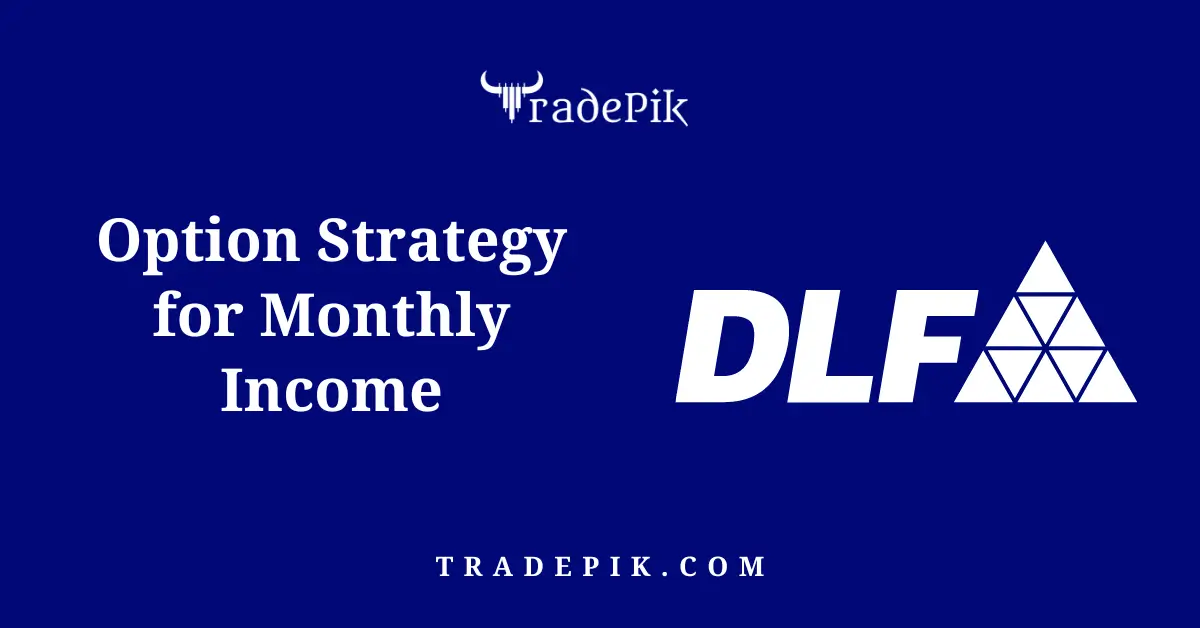DLF Monthly Income Strategy: July 2024 | Profiting with the Iron Butterfly
Discover how to generate monthly income with DLF using the Iron Butterfly options strategy. This guide covers the basics of Iron Butterflies, why DLF is an ideal candidate, and how to implement the strategy for July 2024 expiry.

Ready to transform DLF, a real estate giant in India, into a consistent income generator? The Iron Butterfly options strategy, known for its potential to profit from range-bound markets, could be your key.
In this guide, we'll break down the Iron Butterfly in detail, explain why DLF is well-suited for this strategy, and walk you through setting up the trade for July 2024 expiry.
Whether you're a seasoned options trader or exploring this territory for the first time, this article will give you the knowledge and tools you need to potentially unlock monthly income from DLF.
We'll cover everything from the strategy's mechanics to risk management, empowering you to make informed decisions.
The Iron Butterfly: Your Winged Strategy for Monthly Income
Imagine a strategy that lets you profit even when the market isn't making big moves. That's the power of the Iron Butterfly – an options trading approach that thrives in range-bound markets. Think of it like a butterfly with ironclad wings, providing stability and the potential for consistent gains.
Here's how the Iron Butterfly works its magic:
- Four Options, One Goal: The strategy involves buying and selling a total of four options contracts – two puts and two calls. This creates a specific profit zone where your gains are maximized if the underlying stock (in this case, DLF) stays within a predicted price range.
- Profiting from Predictability: Unlike strategies that rely on the market going up or down, the Iron Butterfly is designed to profit from the market staying relatively still. The more the stock price hovers within your anticipated range, the higher your potential profit.
- Theta Decay: Your Secret Weapon: Remember, options lose value over time. This is called time decay, or theta decay. The Iron Butterfly strategy is structured to take advantage of this decay, allowing you to potentially earn income as time passes, even if the stock price doesn't move much.
The Iron Butterfly's unique structure makes it a powerful tool for generating consistent monthly income, especially when you select the right stock to trade. Let's delve into why DLF could be an ideal candidate for this strategy.
Why DLF? The Ideal Playground for the Iron Butterfly in July 2024
While the Iron Butterfly strategy can be applied to various stocks, DLF stands out as a prime candidate for this strategy in July 2024.

Here's why:
- Range-Bound Expectations: Technical analysis and market sentiment suggest that DLF is likely to trade within a relatively tight range (800 - 850) in the near term. The stock appears to have found support and resistance levels (based on Open Interest), indicating a period of consolidation or sideways movement. This is precisely the environment where the Iron Butterfly thrives.
- Favorable Volatility Levels: Implied volatility (IV) plays a crucial role in options pricing. Currently, DLF's IV is at a level that could make the premiums received from selling options in the Iron Butterfly attractive.
- Limited Catalysts for Significant Price Moves: While earnings reports or major news announcements can trigger volatility, there are no immediate catalysts on the horizon expected to cause a dramatic shift in DLF's price. This further supports the thesis of a range-bound market for the stock.
By implementing the Iron Butterfly strategy on DLF in July 2024, you're essentially betting on the stock's stability.
If DLF stays within the predicted range, you stand to profit from the premiums received from selling the options, as well as the time decay that works in your favor. This makes DLF a compelling choice for traders seeking consistent monthly income with controlled risk.
Managing Risk and Optimizing Your Iron Butterfly
While the Iron Butterfly strategy offers a potential for consistent income in range-bound markets, it's crucial to manage the inherent risks and optimize the strategy for maximum effectiveness:
Risk Management:
- Understanding Maximum Loss: The maximum potential loss in an Iron Butterfly occurs if DLF's price moves significantly beyond either of the outer breakeven points (the strike prices of the long call and long put). In our hypothetical example, this would be if DLF's price falls below ₹800 or rises above ₹850.
- Position Sizing: To control risk, determine an appropriate position size based on your risk tolerance and account size. Never risk more than you can afford to lose.
- Stop-Loss Orders: Consider placing stop-loss orders outside the outer breakeven points. These orders will automatically close your position if the stock price moves too far in either direction, limiting your losses.
- Adjustments: If DLF's price starts to approach or exceed one of the breakeven points, you may need to adjust your strategy. This could involve rolling one or both of the short options to a different strike price or closing out the position entirely.
Optimization Tips:
- Choose the Right Expiration Date: Select an expiration date that aligns with your expectation of DLF remaining range-bound. Typically, a shorter expiration date (e.g., one month) can be ideal, as it allows you to benefit from faster time decay.
- Monitor Implied Volatility (IV): Higher IV leads to higher option premiums, which can work in your favor when selling options. However, be aware that high IV can also increase the risk of larger price swings.
- Choose Strike Prices Carefully: The strike prices you select for the short and long options will significantly impact the risk and reward profile of your Iron Butterfly. Aim for a balance that matches your risk tolerance and profit goals.
By diligently managing risk and optimizing your Iron Butterfly strategy, you can increase your chances of success and potentially generate consistent income from DLF in the July 2024 expiry.
Iron Butterfly Strategy in DLF: A Practical Approach for July 2024
Building on our analysis of DLF's potential for range-bound movement, let's outline a specific Iron Butterfly strategy to consider for the July 2024 expiry:
Here is the DLF strategy that we deployed this month:

Rationale:
This strategy is designed to profit if DLF's price stays within the ₹800 to ₹850 range until expiry. In this scenario, all the options would expire worthless, and you would keep the premiums received from selling the two initial options.
Important Considerations:
- Adjustments: If DLF's price starts to move significantly outside your expected range, you may need to adjust the strategy by rolling your options or closing out the position.
- Expiration Date: Choose an expiration date that aligns with your risk tolerance and outlook for DLF's price movement.
- Premium: Ensure that the premiums received from selling the options are sufficient to cover the cost of buying the protective options and leave you with a potential profit.
Adjustments for this strategy:
- Adjustments are for our premium subscribers! Click on the below button and unlock premium strategies 👇
I will also share the adjustments through email for our paid subscribers. So keep following!
Want to Master Options Strategies Like the Iron Butterfly?
Our Option Strategies: A Mentorship Program 3.0 equips you with the knowledge and skills to confidently implement income-generating strategies like the Iron Butterfly, and many others. Gain access to in-depth training, expert guidance, and a supportive community of traders.
Don't miss out on the opportunity to elevate your options trading game! Enroll now and start your journey toward consistent profits.
DISCLAIMER: – we are not a SEBI research analyst. Views posted here only for educational purposes. There is no liability whatsoever for any loss arising from the use of this product or its contents. This product is not a recommendation to buy or sell, but rather a guideline to interpreting specified analysis methods. This information should only be used by investors and traders who are aware of the risk inherent in securities trading.




